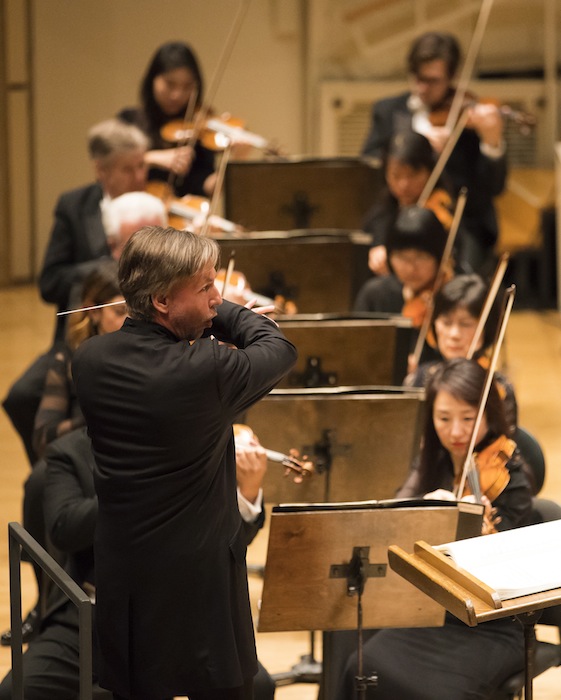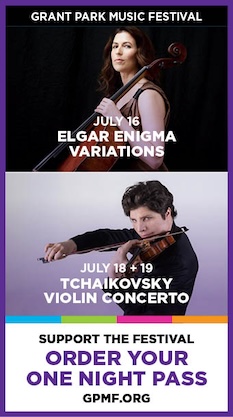A majestic, moving Mahler farewell from Salonen, CSO

Gustav Mahler’s Symphony No. 9 is a work so indelibly associated with its backstory that the history can almost overshadow the music. Overworked and gravely ill from heart disease, the composer would die at age 50, just a year after finishing the Ninth, his last completed work.
But the Ninth Symphony–Mahler’s greatest achievement–transcends the personal circumstances that created it. Scored for huge orchestra, this epic work is outwardly traditional in four movements, but wholly untraditional in its structure and length–spanning nearly ninety minutes with two vast slow movements framing two faster ones. The Ninth is such a rich, complex and multifaceted masterpiece that it is rare for any performance to capture all or even most of its expressive potential and depth.
Esa-Pekka Salonen led the Chicago Symphony Orchestra in the Ninth Symphony Thursday night–107 years nearly to the day of Mahler’s death (May 18, 1911).
The Finnish conductor has taken an incremental approach to Mahler in his career. During his 17-year tenure as music director of the Los Angeles Philharmonic (1992-2009), Salonen concentrated almost exclusively on Mahler’s first four symphonies, doing Nos. 7 and 8 in only one series each, and never programming Nos. 5, 6 nor 9. (His only previous local Mahler performance was the Sixth with the CSO in 2011.)
If the Ninth is a relatively recent addition to his repertoire, at times it felt that way in the long opening movement.
The sighing motif that opens and dominates the Andante comodo was refined and elegant in its initial appearance, returning in more sumptuous style with its first reprise. The sprawling movement was directed with characteristic focus by Salonen, climaxes given due power and brilliance. He marshaled the large forces confidently, and balances were impeccable with the many wind and brass solos emerging with clarity and impact.
And yet at times one felt Salonen feeling his way through the score. Taking quickish tempos, the performance felt impatient, the darker shadows of this movement unexplored; while moments like the stinging, acidic bitterness of the muted horns were manifest, largely missing was the broader sense of psychic dislocation, as both tonality and the score’s leave-taking continually break down in darkness.
Just as one started settling in for a technocratic traversal of this score, the performance found its footing. From the second movement on, Salonen was more in command with the full expressive potential of the music as well as its surface direction.
That second movement–a Ländler on steroids–received its full due, with Salonen and the orchestra, charting the manic permutations as the amiable rustic dance grows more crazed and manically spins out of control. The ensemble precision in this mercurial music was astounding, the Brobdingnagian forces playing with whipcrack brilliance and the intimate cohesion of a string quartet.
In the ensuing Rondo-Burleske, the music here too could have used a greater sense of ferocity in the early going, as well as more effectively pointing the contrast with the distanced benediction of the middle section. The movement’s coda fully captured that sense of wild malevolence and unhinged frenzy.
And so to the final Adagio, where the performance was nearly everything one could wish for. The valedictory sense of the main theme was unmistakeable, the CSO strings playing it with a searing emotional intensity and top-to-bottom richness of amplitude that one thought was no longer possible in the hall’s damaged acoustic.
Salonen was masterful in the finale, leading a performance that conveyed the sense of a farewell to life in all its beauty and joys as well its pain and anguish. Here, there was no sparing of the fitful bleakness of Mahler’s vision either, the spare, forlorn wind solos groping at times in a godless landscape. This leave-taking felt all-encompassing–majestic, unsentimental, humane and forgiving. The closing section, as the music slowly winds down to just the front desk strings, was handled with remarkable control by Salonen and the players, the final notes hovering on the edge of audibility in a haunting, ambivalent solace.
The CSO always seems to rise to the occasion in this score and Thursday night’s magnificent performance provided the musicians’ finest playing of the season, both individually and as a collective.
In the first chair, Mark Ridenour’s trumpet playing was stunning throughout, clarion in tone, nimble in articulation and also rendered with fine lyric delicacy. Similarly, Daniel Gingrich’s horn solos were boldly projected and atmospheric throughout, his section colleagues equally excellent. On the same level were the rest of the brass and winds, especially bassoonist Keith Buncke and flutist Stefán Ragnar Höskuldsson.
Concertmaster Robert Chen and his string colleagues took the top honors in playing that was staggering all night, notably the otherworldly sensitivity they brought to the coda’s gradual, fade away to silence.
Mahler’s Symphony No. 9 will be repeated 1:30 p.m. Friday, 8 p.m Saturday and 7:30 p.m. Tuesday. cso.org; 312-294-3000.
Posted in Uncategorized



Posted May 18, 2018 at 3:03 pm by Dave
Totally agree with your review — movement by movement. The finale was staggering on all levels, and as you said, the Orchestra was at its absolute best last night. The audience (most nights coughing, shuffling, talking) was absolutely silent for the mesmerizing final bars and stayed that way for a solid minute or two after the Orchestra had faded away. A magical moment, and overall, a mind-blowing experience.
Any way Salonen can be convinced to take the CSO reins from Maestro Muti after his assumed 2022 retirement?
Posted May 19, 2018 at 1:19 pm by Lawrence A. Johnson
We can dream.
Posted May 20, 2018 at 12:58 pm by Jim McMillan
I agree as well with most of this review.
The audience WAS abnormally quiet, except for an outburst from some idiot on the main floor after the first movement. I don’t attend to hear unsolicited commentary from the hoi polloi. I was also impressed that the usual idiots yelling “bravo” before the decay of the last note didn’t occur. The silence after the end was, by my calculation, just short of a minute. Impressive, Chicago!
The musicianship shown by the CSO clearly is among the best in the world. I did however note (not for the first time) that the principal viola, Li-Kuo Chang, isn’t at his best anymore with missed tempos and flawed entrances marring the performance. With the other principal Charles Pikler just retiring a few months ago, perhaps Chang is staying on to provide some continuity. Here’s hoping he gets the hint unlike horn principal Dale Clevenger, who needed a spate of bad press and angry subscriber letters before he would go.
As for Salonen taking the helm, it’s not something *I* am wishing for. As a subscriber to the LA Phil during Salonen’s tenure there, I can assure you his penchant for screechy “new music” wouldn’t be welcome here.
Posted May 21, 2018 at 11:52 am by Andrew
I can assure Jim he’s been wrong once or twice.
Posted May 21, 2018 at 1:46 pm by Tod Verklärung
With regard to Mr. Clevenger, his departure was the Music Director’s job to enable. Whatever failure occurred was his responsibility: no one else had the authority or the musical responsibility to take it on without his encouragement. This is always a delicate and difficult task, especially with someone who had a glorious tenure and had made an enormous contribution to the ensemble. Few great athletes, entertainers, or musicians leave ahead of schedule or even on schedule. They are always hoping for a return to form, if indeed they are aware that they no longer have the chops.
Posted Feb 08, 2022 at 9:30 pm by Rand Craig
In response to Andrew, I’m not certain how adventurous Chicago audiences are but I, too, subscribed to the L.A. Phil. during Maestro Salonen’s tenure there. I found, because of his taste, and accomplishment as one of today’s truly exceptional composers, the “screechy” modern music was at a minimum. It’s certainly not what I recall of the many fine performances I attended. I’ve also been following Salonen since he left the LA. directorship. I’m impressed by how he continues to evolve as a conductor. I heard him give an exciting Mahler 8 here, as well as the best “Zarathustra” I’ve ever experienced live. Now, he’s just beginning his tenure up the coast, and I’ll bet he succeeds mightily with San Francisco audiences.